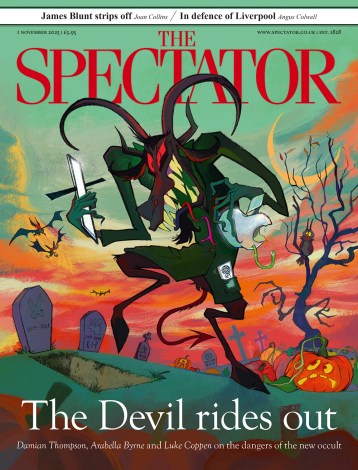Just Stop Oil have spent the past year vandalising their way through the National Gallery in the over-orchestrated manner of a Cluedo suspect. Once it was Constable’s Hay Wain in Room 34 with a bit of glue. Then van Gogh’s Sunflowers in Room 43 with a Warholian can of tomato soup. The newest casualty is Velázquez’s seventeenth-century Rokeby Venus, its protective glass smashed in several places by miniature safety hammers.
Readers may at this point catch onto a sense of déjà vu. The nude Venus had already been victimised in 1914 by suffragette Mary Richardson in the National Gallery with a meat cleaver. She aimed to avenge the government’s treatment of Emmeline Pankhurst – ‘the most beautiful character in modern history’ – by destroying a resounding depiction of physical beauty. The Just Stop Oil connection is intentional. ‘Women did not get the vote by voting,’ explained one of the protesters. ‘It is time for deeds, not words.’
In all their enthusiasm over this clever reference to the painting’s political past, the protestors overlooked two details of the initial act. First, there was Richardson’s meat cleaver, which, when pictured slashing at Venus’ painted flesh, evokes the sleazy, sexualised cannibalism of the Texas Chainsaw Massacre franchise more than it does any modern image of righteous activism. Then there is the fact that the agitator was one of a small group of suffragettes to eventually turn, in the 1930s, to Oswald Mosley’s British Union of Fascists.
Obviously the planned vandalism of a priceless painting is damning enough without the fascist connection. Nobody gains anything from destroying the National Gallery’s great works of art, which should ideally be retained as sources of joy and inspiration for everyone – those who control the oil and gas industries, and those who do not. If any painting should be kept especially sacred, it is the Rokeby Venus. Velázquez’s image, while ostensibly a classical allusion, needs no specialised knowledge to be understood and appreciated.
First there is the nude Venus, who at first glance is daringly stark and white, one great body dominating the horizontal canvas. Walk closer and you will see the carefully-studied signs of a living woman – the glowing shadow under her left knee, the folded skin at her shoulder. The sole mythological giveaways are Cupid’s white wings, but they form such a convincing compositional parallel with the bedsheets below that it is easy to take them for granted, as if they are a coincidental extension of an ordinary child. The artist’s backdrop speaks of no specific place or time – we have no idea whether he intended this to be a Venus of ancient Rome or a Venus of 17th-century Spain. Cupid’s face is lowered, Venus’ reflection masked in shadow. The viewer can read into their expressions whatever they want, or need, to read.
The joke is on Just Stop Oil. They thought they were protesting oil and gas licences, but really they were lending themselves to Velázquez’s visual universe where his images are often self-referential, or referencing the space beyond their frame. His Temptation of St. Thomas traps a cowering prostitute in a shrunken doorway in the background, on the other side of a wall that splits her mundane world from the painting’s central, spiritual scene – she seems to be slipping out behind the painting and into our world. In Christ in the House of Martha and Mary, a seventeenth-century Mary and Martha pose next to a carefully colour-matched painting-within-the-painting of their Biblical counterparts. Las Meninas famously takes the Spanish royal couple and imprisons them in a mirror. They are far outside of the painting’s two-dimensional space. Maybe they stand outside of its frame, gazing in.
Venus is no exception to the picture-in-a-picture rule. She gazes sleepily into Cupid’s mirror, but her reflection is deliberately twisted far beyond where it should be, straight into our line of sight. Velázquez takes the mirror and turns it around for us viewers to see, exposing Venus’ vanity by putting the image right in our line of sight.
Now, a new image has been formed, just as Velázquezean as the first. Two dishevelled activists pose in vain in front of their own special analogy. Like the artist’s influential portrait of Pope Innocent X, and as per the National Gallery’s choice of wallpaper, the couple are surrounded in a deep luminous red. Even the colours are right. This time, when Cupid lifts his distorted glass to the viewer, it’s with a nod to the vanity of a century of empty protest taken out against this painting. Images trump both words and deeds, and Velázquez’s little ironies live on.






Comments